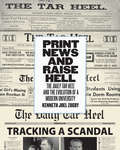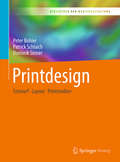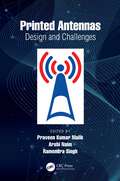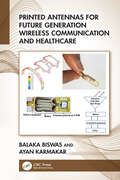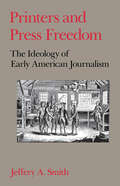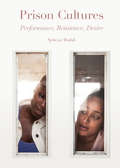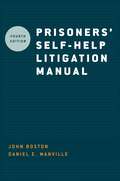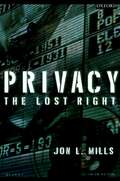- Table View
- List View
Print News and Raise Hell: The Daily Tar Heel and the Evolution of a Modern University
by Kenneth Joel ZogryFor over 125 years, the Daily Tar Heel has chronicled life at the University of North Carolina at Chapel Hill and at times pushed and prodded the university community on issues of local, state, and national significance. Thousands of students have served on its staff, many of whom have gone on to prominent careers in journalism and other influential fields. Print News and Raise Hell engagingly narrates the story of the newspaper's development and the contributions of many of the people associated with it. Kenneth Joel Zogry shows how the paper has wrestled over the years with challenges to academic freedom, freedom of speech, and freedom of the press, while confronting issues such as the evolution of race, gender, and sexual equality on campus and long-standing concerns about the role of major athletics at an institution of higher learning. The story of the paper, the social media platform of its day, uncovers many dramatic but perhaps forgotten events at UNC since the late nineteenth century, and along with many photographs and cartoons not published for decades, opens a fascinating window into Tar Heel history. Examining how the campus and the paper have dealt with many challenging issues for more than a century, Zogry reveals the ways in which the history of the Daily Tar Heel is deeply intertwined with the past and present of the nation's oldest public university.
Printdesign: Entwurf – Layout – Printmedien (Bibliothek der Mediengestaltung)
by Peter Bühler Patrick Schlaich Dominik SinnerDieser Band der „Bibliothek der Mediengestaltung“ behandelt die Grundlagen des Printdesigns: Entwurfstechniken, Layoutgrundlagen, Seitengestaltung, Printprodukte und WerbemedienFür diese Bibliothek wurden die Themen des Kompendiums der Mediengestaltung neu strukturiert, vollständig überarbeitet und in ein handliches Format gebracht. Leitlinien waren hierbei die Anpassung an die Entwicklungen in der Werbe- und Medienbranche sowie die Berücksichtigung der aktuellen Rahmenpläne und Studienordnungen sowie Prüfungsanforderungen der Ausbildungs- und Studiengänge.Die Bände der „Bibliothek der Mediengestaltung“ enthalten zahlreiche praxisorientierte Aufgaben mit Musterlösungen und eignen sich als Lehr- und Arbeitsbücher an Schulen sowie Hochschulen und zum Selbststudium.
Printed Antennas: Design and Challenges
by Praveen Kumar Malik Arshi Naim Ramendra SinghThis collection covers different printed microstrip antenna designs,from rectangular to circular, broadband, dual-band, and millimeter-wave microstrip antennas to microstrip arrays. It further presents a new analysis of the rectangular and circular microstrip antenna efficiency and surface wave phenomena. The book Covers the latest advances and applications of microstrip antennas Discusses methods and techniques used for the enhancement of the performance parameters of the microstrip antenna Presents low-power wide area network (LPWAN) proximity-coupled antenna for Internet of Things applications. Highlights a new analysis of rectangular and circular microstrip antenna efficiency and surface wave phenomena. Showcases implantable antennas, H-shaped antennas, and wideband implantable antennas for biomedical applications Printed Antennas discusses the latest advances such as the Internet of Things for antenna applications, device-to-device communication, satellite communication, and wearable textile antenna in the field of communication. It further presents methods and techniques used for the enhancement of the performance parameters of the microstrip antenna and covers the design of conformal and miniaturized antenna structures for various applications. It will serve as an ideal reference text for senior undergraduates, graduate students, and researchers in fields including electrical engineering, electronics and communications engineering, and computer engineering.
Printed Antennas: Design and Challenges
by Praveen Kumar Malik Arshi Naim Ramendra SinghThis collection covers different printed microstrip antenna designs,from rectangular to circular, broadband, dual-band, and millimeter-wave microstrip antennas to microstrip arrays. It further presents a new analysis of the rectangular and circular microstrip antenna efficiency and surface wave phenomena. The book Covers the latest advances and applications of microstrip antennas Discusses methods and techniques used for the enhancement of the performance parameters of the microstrip antenna Presents low-power wide area network (LPWAN) proximity-coupled antenna for Internet of Things applications. Highlights a new analysis of rectangular and circular microstrip antenna efficiency and surface wave phenomena. Showcases implantable antennas, H-shaped antennas, and wideband implantable antennas for biomedical applications Printed Antennas discusses the latest advances such as the Internet of Things for antenna applications, device-to-device communication, satellite communication, and wearable textile antenna in the field of communication. It further presents methods and techniques used for the enhancement of the performance parameters of the microstrip antenna and covers the design of conformal and miniaturized antenna structures for various applications. It will serve as an ideal reference text for senior undergraduates, graduate students, and researchers in fields including electrical engineering, electronics and communications engineering, and computer engineering.
Printed Antennas for Future Generation Wireless Communication and Healthcare
by Balaka Biswas Ayan KarmakarThis proposed book focuses on the design and development of printed antennas along with modeling aspects for multifaceted applications. It further investigates imperfections in the manufacturing processes and assembly operation during the testing/characterization of printed antennas.This text- Discusses in a comprehensive manner the design and development aspects of printed antennas. Provides fractal engineering aspects for miniaturization and wideband characteristics of the low-profile antenna with high performances. Covers high gain printed antenna for Terahertz application. Showcases electrical modeling of smart antennas. Pedagogical features such as review questions based on practical experiences are included at the end of each chapter. The book comprehensively discusses fractal engineering in printed antennas for miniaturization and enhancement of performance factors. It further covers the modeling of electrically small antennas, circuit modeling, modeling of factual-based Ultra-Wide Band antennas, and modeling of reconfigurable micro-electromechanical system-based patch antennas. The book highlights performance metrics of multiple-input-multiple-output antennas. It will serve as an ideal reference text for senior undergraduate, graduate students, and academic researchers in fields including electrical engineering, electronics, communications engineering, and computer engineering.
Printed Antennas for Future Generation Wireless Communication and Healthcare
by Balaka Biswas Ayan KarmakarThis proposed book focuses on the design and development of printed antennas along with modeling aspects for multifaceted applications. It further investigates imperfections in the manufacturing processes and assembly operation during the testing/characterization of printed antennas.This text- Discusses in a comprehensive manner the design and development aspects of printed antennas. Provides fractal engineering aspects for miniaturization and wideband characteristics of the low-profile antenna with high performances. Covers high gain printed antenna for Terahertz application. Showcases electrical modeling of smart antennas. Pedagogical features such as review questions based on practical experiences are included at the end of each chapter. The book comprehensively discusses fractal engineering in printed antennas for miniaturization and enhancement of performance factors. It further covers the modeling of electrically small antennas, circuit modeling, modeling of factual-based Ultra-Wide Band antennas, and modeling of reconfigurable micro-electromechanical system-based patch antennas. The book highlights performance metrics of multiple-input-multiple-output antennas. It will serve as an ideal reference text for senior undergraduate, graduate students, and academic researchers in fields including electrical engineering, electronics, communications engineering, and computer engineering.
Printed Antennas for Wireless Communications (RSP #19)
by Rod WaterhousePrinted antennas, also known as microstrip antennas, have a variety of beneficial properties including mechanical durability, conformability, compactness and cheap manufacturing costs. As such, they have a range of applications in both the military and commercial sectors, and are often mounted on the exterior of aircraft and spacecraft as well as incorporated into mobile radio communication devices. Printed Antennas for Wireless Communications offers a practical guide to state-of-the-art printed antenna technology used for wireless systems. Contributions from renowned global experts within both academia and industry enable the reader to design printed antennas and associated technologies, and offer valuable insights into important breakthroughs in these areas. Divided into 3 sections covering fundamental wideband printed radiating elements for wireless systems, small printed antennas for wireless systems, and advanced concepts and applications in wireless systems. Provides experimental data and applies theoretical models to present design performance trends and to give the reader an in-depth coverage of the area. Presents summaries of different approaches used in solving wireless systems such as WPAN (wireless personal area network) and MIMO (multi-input/ multi-output), offering the reader an overall perspective of the pros and cons of each. Focuses on practical design, examples and ‘real world’ solutions. Printed Antennas for Wireless Communications offers an excellent insight on printed antennas from the theoretical to the practical; hence it will appeal to practicing design engineers within commercial and governmental/ military organistations, as well as postagraduate students and researchers in communications technology
Printed Propaganda under Louis XIV: Absolute Monarchy and Public Opinion
by Joseph KlaitsIn the late seventeenth century the role of printed propaganda in manipulating public consciousness became increasingly explicit, and governments developed systematic controls over the printed word. This book considers the purposes, mechanisms, content, and audience of royal printed propaganda in early modern France. The author first sketches the impact of the invention of printing and characterizes propaganda generally during the reign of Louis XIV. In succeeding chapters he discusses the theory and practice of censorship and the government's relationships with the recently established French periodical press, presenting a balanced portrait of the crown's objectives and mixed success in influencing the sources of opinion. The varieties of government-inspired pamphlet propaganda are carefully and extensively analyzed, and signed royal propaganda receives special attention.Originally published in 1977.The Princeton Legacy Library uses the latest print-on-demand technology to again make available previously out-of-print books from the distinguished backlist of Princeton University Press. These editions preserve the original texts of these important books while presenting them in durable paperback and hardcover editions. The goal of the Princeton Legacy Library is to vastly increase access to the rich scholarly heritage found in the thousands of books published by Princeton University Press since its founding in 1905.
Printers and Press Freedom: The Ideology of Early American Journalism
by Jeffery A. SmithIn the United States, the press has sometimes been described as an unoffical fourth branch of government, a branch that serves as a check on the other three and provides the information necessary for a democracy to function. Freedom of the press--guaranteed but not defined by the First Amendment of the Constitution--can be fully understood only when examined in the context of the political and intellectual experiences of 18th-century America. Here, Jeffery A. Smith explores how Madison, Franklin, Jefferson, and their contemporaries came to see liberty of the press as a natural and vital part of a democratic republic. Drawing on sources ranging from political philosophers to court records and newspaper essayists, Printers and Press Freedom traces the development of a widespread conception of the press as necessarily exempt from all government restrictions, but still liable for the defamation of individuals. Smith carefully analyzes libertarian press theory and practice in the context of republican ideology and Enlightenment thought--paying particular attention to the cases of Benjamin Franklin and his relatives and associates in the printing business--and concludes that the generation that produced the First Amendment believed that government should not be trusted and that the press needed the broadest possible protection in order to serve as a check on the misuse of power.
The Printing Ink Manual
by Robert LeachThe Printing Ink Manual was first published in 1961 under the auspices of the Society of British Printing Ink Manufacturers with the object of providing an authoritative work on printing ink technology. This, the fourth edition, continues that purpose and presents a comprehensive study of the current 'state of the art' in the ink industry. For those starting in the printing ink industry it is a textbook dealing with all aspects of the formulation and manufacture of printing ink. For the ink technician it is a practical manual and useful source of reference. For printers and users of printed material the manual supplies helpful information on the nature and behaviour of ink both on the printing press and as the finished print. Readers with a little scientific knowledge will have no difficulty in using the manual. but as in previous editions, sufficient chemistry and physics have been introduced to assist the advanced technician and research scientist.
The Printing Ink Manual
by Robert Leach Ray PierceThe first edition of the Printing Ink Manual was published by the Society of British Printing Ink Manufacturers in 1961 to fill the need for an authorative textbook on printing technology, which would serve both as a training manual and a reliable reference book for everyday use. The book soon became established as a standard source of information on printing inks and reached its fourth edition by 1988. This, the fifth edition, is being published only five years later, so rapid has been the development in technology. The objective of the Printing Ink Manual remains unchanged. It is a practical handbook designed for use by everyone engaged in the printing ink industry and the associated industries. It provides all the information required by the ink technical for the day-to-day formulation of printing inks. It supplies the factory manager with details of the latest equipment and manufacturing methods, including large-scale production, and gives guidance on achieving quality assessment and total quality management specifications. Care has been taken to maintain the value of the Manual for training both technical personnel and others who requiresome kn- ledge of inks. Readers with little scientific knowledge will not find dif- culty in using the Manual, but sufficient chemistry and physics have been included to provide an explanation of the underlying principles and theories governing the behaviour of inks for use by the advanced te- nologist. Suppliers of raw materials, substrate manufacturers, printers and print users will find the book a valuable source of information.
Prison Cultures: Performance, Resistance, Desire
by Alwyn Walsh Aylwyn WalshPrison Cultures offers the first systematic examination of women in prison and performances in and of the institution. Using a feminist approach to reach beyond tropes of “bad girls” and simplistic inside vs. outside dynamics, it examines how cultural products can perpetuate or disrupt hegemonic understandings of the world of prisons.
Prisoners' Self-Help Litigation Manual
by John Boston Daniel E ManvillePrisoners' Self-Help Litigation Manual, in its much-anticipated fourth edition, is an indispensable guide for prisoners and prisoner advocates seeking to understand the rights guaranteed to prisoners by law and how to protect those rights. Clear, comprehensive, practical advice provides prisoners with everything they need to know on conditions of confinement, civil liberties in prison, procedural due process, the legal system, how to litigate, conducting effective legal research, and writing legal documents. Written by two legal and penitentiary experts with intimate knowledge of prisoner's rights and legal aid work, authors John Boston and Daniel E. Manville strategically focus on federal constitutional law, providing prisoners and those wishing to assist them with the most important information concerning legal rights. Over the past decade, prison law and conditions have changed significantly. This new edition is updated to include the most relevant prisoners' rights topics and approaches to litigation. Updates include all aspects of prison life as well as material on legal research, legal writing, types of legal remedies, and how to effectively use those remedies. Certainly the most authoritative, well-organized and relevant prisoner's rights manual available - - the eagerly awaited fourth edition should be purchased by everyone interested in civil rights for the incarcerated.
Prisoners' Self-Help Litigation Manual
by John Boston Daniel E ManvillePrisoners' Self-Help Litigation Manual, in its much-anticipated fourth edition, is an indispensable guide for prisoners and prisoner advocates seeking to understand the rights guaranteed to prisoners by law and how to protect those rights. Clear, comprehensive, practical advice provides prisoners with everything they need to know on conditions of confinement, civil liberties in prison, procedural due process, the legal system, how to litigate, conducting effective legal research, and writing legal documents. Written by two legal and penitentiary experts with intimate knowledge of prisoner's rights and legal aid work, authors John Boston and Daniel E. Manville strategically focus on federal constitutional law, providing prisoners and those wishing to assist them with the most important information concerning legal rights. Over the past decade, prison law and conditions have changed significantly. This new edition is updated to include the most relevant prisoners' rights topics and approaches to litigation. Updates include all aspects of prison life as well as material on legal research, legal writing, types of legal remedies, and how to effectively use those remedies. Certainly the most authoritative, well-organized and relevant prisoner's rights manual available - - the eagerly awaited fourth edition should be purchased by everyone interested in civil rights for the incarcerated.
Privacy: The Lost Right
by Jon L MillsThe disturbing reality of contemporary life is that technology has laid bare the private facts of most people's lives. Email, cell phone calls, and individual purchasing habits are no longer secret. Individuals may be discussed on a blog, victimized by an inaccurate credit report, or have their email read by an employer or government agency without their knowledge. Government policy, mass media, and modern technology pose new challenges to privacy rights, while the law struggles to keep up with the rapid changes. Privacy: The Lost Right evaluates the status of citizens' right to privacy in today's intrusive world. Mills reviews the history of privacy protections, the general loss of privacy, and the inadequacy of current legal remedies, especially with respect to more recent privacy concerns, such as identity theft, government surveillance, tabloid journalism, and video surveillance in public places. Mills concludes that existing regulations do not adequately protect individual privacy, and he presents options for improving privacy protections.
Privacy and Capitalism in the Age of Social Media (Routledge Research in Information Technology and Society)
by Sebastian SevignaniThis book explores commodification processes of personal data and provides a critical framing of the ongoing debate of privacy in the Internet age, using the example of social media and referring to interviews with users. It advocates and expands upon two main theses: First, people’s privacy is structurally invaded in contemporary informational capitalism. Second, the best response to this problem is not accomplished by invoking the privacy framework as it stands, because it is itself part of the problematic nexus that it struggles against. Informational capitalism poses weighty problems for making the Internet a truly social medium, and aspiring to sustainable privacy simultaneously means to struggle against alienation and exploitation. In the last instance, this means opposing the capitalist form of association – online and offline.
Privacy and Capitalism in the Age of Social Media (Routledge Research in Information Technology and Society #18)
by Sebastian SevignaniThis book explores commodification processes of personal data and provides a critical framing of the ongoing debate of privacy in the Internet age, using the example of social media and referring to interviews with users. It advocates and expands upon two main theses: First, people’s privacy is structurally invaded in contemporary informational capitalism. Second, the best response to this problem is not accomplished by invoking the privacy framework as it stands, because it is itself part of the problematic nexus that it struggles against. Informational capitalism poses weighty problems for making the Internet a truly social medium, and aspiring to sustainable privacy simultaneously means to struggle against alienation and exploitation. In the last instance, this means opposing the capitalist form of association – online and offline.
Privacy and Disclosure of Hiv in interpersonal Relationships: A Sourcebook for Researchers and Practitioners (Routledge Communication Series)
by Kathryn Greene Valerian J. Derlega Gust A. Yep Sandra PetronioAs the HIV epidemic enters its third decade, it remains one of the most pressing health issues of our time. Many aspects of the disease remain under-researched and inadequate attention has been given to the implications for the relationships and daily lives of those affected by HIV. Disclosing an HIV diagnosis remains a decision process fraught with difficulty and despite encouraging medical advances, an HIV diagnosis creates significant anxiety and distress about one's health, self-identity, and close relationships. This book provides an overarching view of existing research on privacy and disclosure while bringing together two significant areas: self-disclosure as a communication process and the social/relational consequences of HIV/AIDS. The unifying framework is communication privacy management and the focus of this volume is on private voluntary relational disclosure as opposed to forced or public disclosure. Utilizing numerous interviews with HIV patients and their families, the authors examine disclosure in a variety of social contexts, including relationships with intimate partners, families, friends, health workers, and coworkers. Of note are the examinations of predictors of willingness to disclose HIV infection, the message features of disclosure, and the consequences of both disclosure and non-disclosure. This volume, with its personal exercises and sources of additional information, offers an invaluable resource for individuals living with HIV and their significant others, as well as for professionals in the fields of health communication, social and health psychology, family therapy, clinical and counseling psychology, relationship research, infectious disease, and social service.
Privacy and Disclosure of Hiv in interpersonal Relationships: A Sourcebook for Researchers and Practitioners (Routledge Communication Series)
by Kathryn Greene Valerian J. Derlega Gust A. Yep Sandra PetronioAs the HIV epidemic enters its third decade, it remains one of the most pressing health issues of our time. Many aspects of the disease remain under-researched and inadequate attention has been given to the implications for the relationships and daily lives of those affected by HIV. Disclosing an HIV diagnosis remains a decision process fraught with difficulty and despite encouraging medical advances, an HIV diagnosis creates significant anxiety and distress about one's health, self-identity, and close relationships. This book provides an overarching view of existing research on privacy and disclosure while bringing together two significant areas: self-disclosure as a communication process and the social/relational consequences of HIV/AIDS. The unifying framework is communication privacy management and the focus of this volume is on private voluntary relational disclosure as opposed to forced or public disclosure. Utilizing numerous interviews with HIV patients and their families, the authors examine disclosure in a variety of social contexts, including relationships with intimate partners, families, friends, health workers, and coworkers. Of note are the examinations of predictors of willingness to disclose HIV infection, the message features of disclosure, and the consequences of both disclosure and non-disclosure. This volume, with its personal exercises and sources of additional information, offers an invaluable resource for individuals living with HIV and their significant others, as well as for professionals in the fields of health communication, social and health psychology, family therapy, clinical and counseling psychology, relationship research, infectious disease, and social service.
Privacy and Security for Mobile Crowdsourcing (River Publishers Series in Digital Security and Forensics)
by Shabnam SodagariThis concise guide to mobile crowdsourcing and crowdsensing vulnerabilities and countermeasures walks readers through a series of examples, discussions, tables, initiative figures, and diagrams to present to them security and privacy foundations and applications. Discussed approaches help build intuition to apply these concepts to a broad range of system security domains toward dimensioning of next generations of mobiles crowdsensing applications. This book offers vigorous techniques as well as new insights for both beginners and seasoned professionals. It reflects on recent advances and research achievements. Technical topics discussed in the book include but are not limited to: Risks affecting crowdsensing platforms Spatio-temporal privacy of crowdsourced applications Differential privacy for data mining crowdsourcing Blockchain-based crowdsourcing Secure wireless mobile crowdsensing. This book is accessible to readers in mobile computer/communication industries as well as academic staff and students in computer science, electrical engineering, telecommunication systems, business information systems, and crowdsourced mobile app developers.
Privacy and Security for Mobile Crowdsourcing (River Publishers Series in Digital Security and Forensics)
by Shabnam SodagariThis concise guide to mobile crowdsourcing and crowdsensing vulnerabilities and countermeasures walks readers through a series of examples, discussions, tables, initiative figures, and diagrams to present to them security and privacy foundations and applications. Discussed approaches help build intuition to apply these concepts to a broad range of system security domains toward dimensioning of next generations of mobiles crowdsensing applications. This book offers vigorous techniques as well as new insights for both beginners and seasoned professionals. It reflects on recent advances and research achievements. Technical topics discussed in the book include but are not limited to: Risks affecting crowdsensing platforms Spatio-temporal privacy of crowdsourced applications Differential privacy for data mining crowdsourcing Blockchain-based crowdsourcing Secure wireless mobile crowdsensing. This book is accessible to readers in mobile computer/communication industries as well as academic staff and students in computer science, electrical engineering, telecommunication systems, business information systems, and crowdsourced mobile app developers.
Privacy and the Role of International Law in the Digital Age (Oxford Data Protection & Privacy Law)
by Kinfe YilmaThis book examines the role of international law in securing privacy and data protection in the digital age. Driven mainly by the transnational nature of privacy threats involving private actors as well as States, calls are increasingly made for an international privacy framework to meet these challenges. Mapped against a flurry of global privacy initiatives, the book provides the first comprehensive analysis of the extent to which and whether international law attends to the complexities of upholding digital privacy. The book starts by exploring boundaries of international privacy law in upholding privacy and data protection in the digital ecosystem where threats to privacy are increasingly transnational, sophisticated and privatized. It then explores the potential of global privacy initiatives, namely Internet bills of rights, universalization of regional systems of data privacy protection, and the multi-level privacy discourse at the United Nations, in reimagining the normative contours of international privacy law. Having shown limitations of global privacy initiatives, the book proposes a pragmatic approach that could make international privacy law better-equipped in the digital age.
Privacy and the Role of International Law in the Digital Age (Oxford Data Protection & Privacy Law)
by Kinfe YilmaThis book examines the role of international law in securing privacy and data protection in the digital age. Driven mainly by the transnational nature of privacy threats involving private actors as well as States, calls are increasingly made for an international privacy framework to meet these challenges. Mapped against a flurry of global privacy initiatives, the book provides the first comprehensive analysis of the extent to which and whether international law attends to the complexities of upholding digital privacy. The book starts by exploring boundaries of international privacy law in upholding privacy and data protection in the digital ecosystem where threats to privacy are increasingly transnational, sophisticated and privatized. It then explores the potential of global privacy initiatives, namely Internet bills of rights, universalization of regional systems of data privacy protection, and the multi-level privacy discourse at the United Nations, in reimagining the normative contours of international privacy law. Having shown limitations of global privacy initiatives, the book proposes a pragmatic approach that could make international privacy law better-equipped in the digital age.
Privacy-Enhancing Aggregation Techniques for Smart Grid Communications (Wireless Networks)
by Rongxing LuThis book provides an overview of security and privacy issues in smart grid communications, as well as the challenges in addressing these issues. It also introduces several privacy enhancing aggregation techniques including multidimensional data aggregation, subset data aggregation, multifunctional data aggregation, data aggregation with fault tolerance, data aggregation with differential privacy, and data aggregation with integrity protection. Offering a comprehensive exploration of various privacy preserving data aggregation techniques, this book is an exceptional resource for the academics, researchers, and graduate students seeking to exploit secure data aggregation techniques in smart grid communications and Internet of Things (IoT) scenarios.
Privacy-Enhancing Fog Computing and Its Applications (SpringerBriefs in Electrical and Computer Engineering)
by Xiaodong Lin Jianbing Ni Xuemin Sherman ShenThis SpringerBrief covers the security and privacy challenges in fog computing, and proposes a new secure and privacy-preserving mechanisms to resolve these challenges for securing fog-assisted IoT applications. Chapter 1 introduces the architecture of fog-assisted IoT applications and the security and privacy challenges in fog computing. Chapter 2 reviews several promising privacy-enhancing techniques and illustrates examples on how to leverage these techniques to enhance the privacy of users in fog computing. Specifically, the authors divide the existing privacy-enhancing techniques into three categories: identity-hidden techniques, location privacy protection and data privacy enhancing techniques. The research is of great importance since security and privacy problems faced by fog computing impede the healthy development of its enabled IoT applications. With the advanced privacy-enhancing techniques, the authors propose three secure and privacy-preserving protocols for fog computing applications, including smart parking navigation, mobile crowdsensing and smart grid. Chapter 3 introduces identity privacy leakage in smart parking navigation systems, and proposes a privacy-preserving smart parking navigation system to prevent identity privacy exposure and support efficient parking guidance retrieval through road-side units (fogs) with high retrieving probability and security guarantees. Chapter 4 presents the location privacy leakage, during task allocation in mobile crowdsensing, and propose a strong privacy-preserving task allocation scheme that enables location-based task allocation and reputation-based report selection without exposing knowledge about the location and reputation for participators in mobile crowdsensing. Chapter 5 introduces the data privacy leakage in smart grid, and proposes an efficient and privacy-preserving smart metering protocol to allow collectors (fogs) to achieve real-time measurement collection with privacy-enhanced data aggregation. Finally, conclusions and future research directions are given in Chapter 6. This brief validates the significant feature extension and efficiency improvement of IoT devices without sacrificing the security and privacy of users against dishonest fog nodes. It also provides valuable insights on the security and privacy protection for fog-enabled IoT applications. Researchers and professionals who carry out research on security and privacy in wireless communication will want to purchase this SpringerBrief. Also, advanced level students, whose main research area is mobile network security will also be interested in this SpringerBrief.
